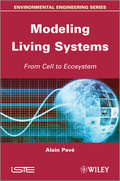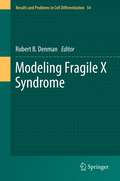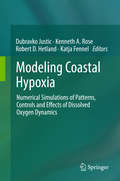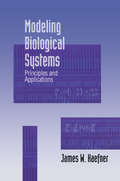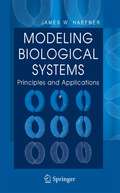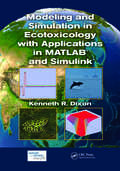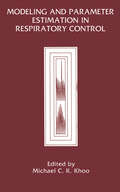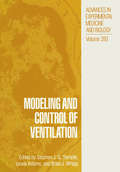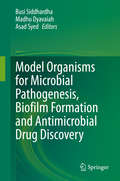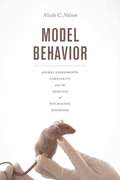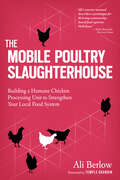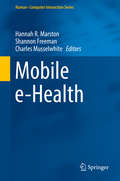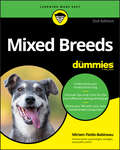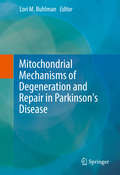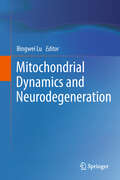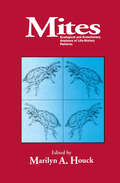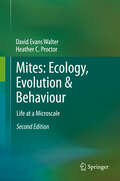- Table View
- List View
Modeling of Living Systems: From Cell to Ecosystem
by Alain PavéModeling is now one of the most efficient methodologies in life sciences. From practice to theory, this book develops this approach illustrated by many examples; general concepts and the current state of the art are also presented and discussed. An historical and general introduction informs the reader how mathematics and formal tools are used to solve biological problems at all levels of the organization of life. The core of this book explains how this is done, based on practical examples coming, for the most part, from the author’s personal experience. In most cases, data are included so that the reader can follow the reasoning process and even reproduce calculus. The final chapter is devoted to essential concepts and current developments. The main mathematical tools are presented in an appendix to the book and are written in an adapted language readable by scientists, professionals or students, with a basic knowledge of mathematics.
Modeling of Living Systems: From Cell to Ecosystem
by Alain PavéModeling is now one of the most efficient methodologies in life sciences. From practice to theory, this book develops this approach illustrated by many examples; general concepts and the current state of the art are also presented and discussed. An historical and general introduction informs the reader how mathematics and formal tools are used to solve biological problems at all levels of the organization of life. The core of this book explains how this is done, based on practical examples coming, for the most part, from the author’s personal experience. In most cases, data are included so that the reader can follow the reasoning process and even reproduce calculus. The final chapter is devoted to essential concepts and current developments. The main mathematical tools are presented in an appendix to the book and are written in an adapted language readable by scientists, professionals or students, with a basic knowledge of mathematics.
Modeling Fragile X Syndrome (Results and Problems in Cell Differentiation #54)
by Robert B. DenmanIntroduction.-Probing Astrocyte Function in Fragile X Syndrome.- Neural Stem Cells.- Fragile X Mental Retardation Protein (FMRP) and the Spinal Sensory System.– The Role of the Postsynaptic Density in the Pathology of the Fragile X Syndrome.- Behavior in a Drosophila model of Fragile X.- Molecular and Genetic Analysis of the Drosophila Model of Fragile X Syndrome.- Fragile X Mental Retardation Protein and Stem Cells.- Manipulating the Fragile X Mental Retardation Proteins in the Frog.- Exploring the Zebra finch Taeniopygia gutta as a Novel Animal Model for the Speech-language Deficit of Fragile X Syndrome.- Neuroendocrine Alterations in the Fragile X Mouse.- Taking STEPs forward to understanding Fragile X Syndrome.- Fmr-1 as an Offspring Genetic and a Maternal Environmental Factor in Neurodevelopmental Disease.- Mouse Models of the Fragile X Premutation and the Fragile X Associated Tremor/Ataxia Syndrome.- Clinical Aspects of the Fragile X Syndrome.- Fragile X Syndrome: A Psychiatric Perspective.- Fragile X Syndrome and Targeted Treatment Trials.- The Fragile X-associate Tremor Ataxia Syndrome.- Vignettes: Models in Absentia.
Modeling Coastal Hypoxia: Numerical Simulations of Patterns, Controls and Effects of Dissolved Oxygen Dynamics
by Dubravko Justic Kenneth A. Rose Robert D. Hetland Katja FennelThis book provides a snapshot of representative modeling analyses of coastal hypoxia and its effects. Hypoxia refers to conditions in the water column where dissolved oxygen falls below levels that can support most metazoan marine life (i.e., 2 mg O2 l-1). The number of hypoxic zones has been increasing at an exponential rate since the 1960s; there are currently more than 600 documented hypoxic zones in the estuarine and coastal waters worldwide. Hypoxia develops as a synergistic product of many physical and biological factors that affect the balance of dissolved oxygen in seawater, including temperature, solar radiation, wind, freshwater discharge, nutrient supply, and the production and decay of organic matter. A number of modeling approaches have been increasingly used in hypoxia research, along with the more traditional observational and experimental studies. Modeling is necessary because of rapidly changing coastal circulation and stratification patterns that affect hypoxia, the large spatial extent over which hypoxia develops, and limitations on our capabilities to directly measure hypoxia over large spatial and temporal scales. This book consists of 15 chapters that are broadly organized around three main topics: (1) Modeling of the physical controls on hypoxia, (2) Modeling of biogeochemical controls and feedbacks, and, (3) Modeling of the ecological effects of hypoxia. The final chapter is a synthesis chapter that draws generalities from the earlier chapters, highlights strengths and weaknesses of the current state-of-the-art modeling, and offers recommendations on future directions.
Modeling Biological Systems: Principles and Applications
by James W. HaefnerThis book is intended as a text for a first course on creating and analyzing computer simulation models of biological systems. The expected audience for this book are students wishing to use dynamic models to interpret real data mueh as they would use standard statistical techniques. It is meant to provide both the essential principles as well as the details and equa tions applicable to a few particular systems and subdisciplines. Biological systems, however, encompass a vast, diverse array of topics and problems. This book discusses only a select number of these that I have found to be useful and interesting to biologists just beginning their appreciation of computer simulation. The examples chosen span classical mathematical models of well-studied systems to state-of-the-art topics such as cellular automata and artificial life. I have stressed the relationship between the models and the biology over mathematical analysis in order to give the reader a sense that mathematical models really are useful to biologists. In this light, I have sought examples that address fundamental and, I think, interesting biological questions. Almost all of the models are directly COIIl pared to quantitative data to provide at least a partial demonstration that some biological models can accurately predict.
Modeling Biological Systems: Principles and Applications
by James W. HaefnerI Principles 1 1 Models of Systems 3 1. 1 Systems. Models. and Modeling . . . . . . . . . . . . . . . . . . . . 3 1. 2 Uses of Scientific Models . . . . . . . . . . . . . . . . . . . . . . . . 4 1. 3 Example: Island Biogeography . . . . . . . . . . . . . . . . . . . . . 6 1. 4 Classifications of Models . . . . . . . . . . . . . . . . . . . . . . . . 10 1. 5 Constraints on Model Structure . . . . . . . . . . . . . . . . . . . . . 12 1. 6 Some Terminology . . . . . . . . . . . . . . . . . . . . . . . . . . . 12 1. 7 Misuses of Models: The Dark Side . . . . . . . . . . . . . . . . . . . 13 1. 8 Exercises . . . . . . . . . . . . . . . . . . . . . . . . . . . . . . . . 15 2 The Modeling Process 17 2. 1 Models Are Problems . . . . . . . . . . . . . . . . . . . . . . . . . . 17 2. 2 Two Alternative Approaches . . . . . . . . . . . . . . . . . . . . . . 18 2. 3 An Example: Population Doubling Time . . . . . . . . . . . . . . . . 24 2. 4 Model Objectives . . . . . . . . . . . . . . . . . . . . . . . . . . . . 28 2. 5 Exercises . . . . . . . . . . . . . . . . . . . . . . . . . . . . . . . . 30 3 Qualitative Model Formulation 32 3. 1 How to Eat an Elephant . . . . . . . . . . . . . . . . . . . . . . . . . 32 3. 2 Forrester Diagrams . . . . . . . . . . . . . . . . . . . . . . . . . . . 33 3. 3 Examples . . . . . . . . . . . . . . . . . . . . . . . . . . . . . . . . 36 3. 4 Errors in Forrester Diagrams . . . . . . . . . . . . . . . . . . . . . . 44 3. 5 Advantages and Disadvantages of Forrester Diagrams . . . . . . . . . 44 3. 6 Principles of Qualitative Formulation . . . . . . . . . . . . . . . . . . 45 3. 7 Model Simplification . . . . . . . . . . . . . . . . . . . . . . . . . . 47 3. 8 Other Modeling Problems . . . . . . . . . . . . . . . . . . . . . . . . 49 viii Contents . . . . . . . . . . . . . . . . . . . . . . . . . . . . . . . . 3. 9 Exercises 53 4 Quantitative Model Formulation: I 4. 1 From Qualitative to Quantitative . . . . . . . . . . . . . . . . . Finite Difference Equations and Differential Equations 4. 2 . . . . . . . . . . . . . . . . 4. 3 Biological Feedback in Quantitative Models . . . . . . . . . . . . . . . . . . . . . . . . . . 4. 4 Example Model . . . . . . . . . . . . . . . . . . . . . . . . . . . . . 4. 5 Exercises 5 Quantitative Model Formulation: I1 81 . . . . . . . . . . . . . . . . . . . . . . . . . . . 5. 1 Physical Processes 81 . . . . . . . . . . . . . . . 5. 2 Using the Toolbox of Biological Processes 89 . . . . . . . . . . . . . . . . . . . . . . . . . . . . 5. 3 Useful Functions 96 . . . . . . . . . . . . . . . . . . . . . . . . . . . . . . . . 5. 4 Examples 102 . . . . . . . . . . . . . . . . . . . . . . . . . . . . . . . . 5. 5 Exercises 104 6 Numerical Techniques 107 . . . . . . . . . . . . . . . . . . . . . . . 6. 1 Mistakes Computers Make 107 . . . . . . . . . . . . . . . . . . . . . . . . . . 6. 2 Numerical Integration 110 . . . . . . . . . . . . . . . . 6. 3 Numerical Instability and Stiff Equations 115 . . . . . . . . . . . . . .
Modeling and Simulation in Ecotoxicology with Applications in MATLAB and Simulink
by Kenneth R. DixonExploring roles critical to environmental toxicology, Modeling and Simulation in Ecotoxicology with Applications in MATLAB and Simulink covers the steps in modeling and simulation from problem conception to validation and simulation analysis. Using the MATLAB and Simulink programming languages, the book presents examples of mathematical functions a
Modeling and Parameter Estimation in Respiratory Control
by M. C. K. KhooExperimentalists tend to revel in the complexity and multidimensionality of biological processes. Modelers, on the other hand, generally look towards parsimony as a guiding prin ciple in their approach to understanding physiological systems. It is therefore not surprising that a substantial degree of miscommunication and misunderstanding still exists between the two groups of truth-seekers. However, there have been numerous instances in physiology where the marriage of mathematical modeling and experimentation has led to powerful in sights into the mechanisms being studied. Respiratory control represents one area in which this kind of cross-pollination has proven particularly fruitful. While earlier modeling ef forts were directed primarily at the chemical control of ventilation, more recent studies have extended the scope of modeling to include the neural and mechanical aspects pertinent to respiratory control. As well, there has been a greater awareness of the need to incorpo rate interactions with other organ systems. Nevertheless, it is necessary from time to time to remind experimentalists of the existence of modelers, and vice versa. The 4th Annual Biomedical Simulations Resource (BMSR) Short Course was held in Marina Del Rey on May 21-22,1989, to acquaint respiratory physiologists and clinical researchers with state-of-the art methodologies in mathematical modeling, experiment design and data analysis, as well as to provide an opportunity for experimentalists to challenge modelers with their more recent findings.
Modeling and Control of Ventilation (Advances in Experimental Medicine and Biology #393)
by Stephen J. G. Semple Lewis Adams Brian J. WhippThe origins of what have come to be known as the "Oxford" Conferences on modelling and the control of breathing can be traced back to a discussion between Dan Cunningham and Richard Hercynski at a conference dinner at the Polish Academy of Sciences in 1971. Each felt that they had benefited from the different perspectives from which the topic of ventilatory control was approached - predominantly physiological in the case of Dr Cunningham and predominantly mathematical in the case of Dr Hercynski. Their judgement at that time was that a conference on the control of breathing which allowed investigators with these different (but related) scientific perspectives to present and discuss their work, might prove fruitful. We would judge that this has amply been borne out, based upon the success of the series of conferences which resulted from that seminal dinner conversation. The first conference, entitled "Modelling of a Biological Control System: The Regulation of Breathing" was held in Oxford, UK, in 1978. Subsequent conferences were: "Modelling and the Control of Breathing" at Lake Arrowhead, California, in 1982; "Con cepts and Formulations in the Control of Breathing" in Solignac, France, in 1985; "Respi ratory Control: A Modeling Perspective" at Grand Lakes, Colorado, in 1988; and "Control of Breathing and Its Modelling Persepctive" at the Fuji Institute in Japan in 1991. The conferences, subsequent to the one in Oxford, have all resulted in well-received published proceedings.
Model Organisms to Study Biological Activities and Toxicity of Nanoparticles
by Busi Siddhardha Madhu Dyavaiah Kaviyarasu KasinathanThis book provides a comprehensive overview of state-of-the-art applications of nanotechnology in biology and medicine, as well as model organisms that can help us understand the biological activity and associated toxicity of nanoparticles, and devise strategies to minimize toxicity and enhance therapies. Thanks to their high surface-to-volume ratio, nanoparticles are characterized by excellent biocompatibility and bioavailability, a high therapeutic index, and relatively low toxicity, which has led to their widespread application in the early diagnosis of diseases, comprehensive monitoring of disease progression, and improved therapeutics. The book also explores nanoparticle-based insecticides and their mechanisms of action, and provides a comparative analysis of the various model organisms that are used to understand the biological properties of nanoparticles. Further, it describes various in-vivo models that yield important insights into nanomaterial-mediated toxicity, promoting the optimal utilization of nanoparticles. In closing, the book discusses future perspectives and regulatory issues concerning the use of nanomaterials in translational research.
Model Organisms for Microbial Pathogenesis, Biofilm Formation and Antimicrobial Drug Discovery
by Busi Siddhardha Madhu Dyavaiah Asad SyedThis book provides essential insights into microbial pathogenesis, host-pathogen interactions, and the anti-microbial drug resistance of various human pathogens on the basis of various model organisms. The initial sections of the book introduce readers to the mechanisms of microbial pathogenesis, host-pathogen interactions, anti-microbial drug resistance, and the dynamics of biofilm formation. Due to the emergence of various microbial resistant strains, it is especially important to understand the prognosis for microbial infections, disease progression profiles, and mechanisms of resistance to antibiotic therapy in order to develop novel therapeutic strategies. In turn, the second part of the book presents a comparative analysis of various animal models to help readers understand microbial pathogenesis, host-pathogen interactions, anti-microbial drug discovery, anti-biofilm therapeutics, and treatment regimes. Given its scope, the book represents a valuable asset for microbiologists, biotechnologists, medical professionals, drug development researchers, and pharmacologists alike.
Model Behavior: Animal Experiments, Complexity, and the Genetics of Psychiatric Disorders
by Nicole C. NelsonMice are used as model organisms across a wide range of fields in science today—but it is far from obvious how studying a mouse in a maze can help us understand human problems like alcoholism or anxiety. How do scientists convince funders, fellow scientists, the general public, and even themselves that animal experiments are a good way of producing knowledge about the genetics of human behavior? In Model Behavior, Nicole C. Nelson takes us inside an animal behavior genetics laboratory to examine how scientists create and manage the foundational knowledge of their field. Behavior genetics is a particularly challenging field for making a clear-cut case that mouse experiments work, because researchers believe that both the phenomena they are studying and the animal models they are using are complex. These assumptions of complexity change the nature of what laboratory work produces. Whereas historical and ethnographic studies traditionally portray the laboratory as a place where scientists control, simplify, and stabilize nature in the service of producing durable facts, the laboratory that emerges from Nelson’s extensive interviews and fieldwork is a place where stable findings are always just out of reach. The ongoing work of managing precarious experimental systems means that researchers learn as much—if not more—about the impact of the environment on behavior as they do about genetics. Model Behavior offers a compelling portrait of life in a twenty-first-century laboratory, where partial, provisional answers to complex scientific questions are increasingly the norm.
Model Behavior: Animal Experiments, Complexity, and the Genetics of Psychiatric Disorders
by Nicole C. NelsonMice are used as model organisms across a wide range of fields in science today—but it is far from obvious how studying a mouse in a maze can help us understand human problems like alcoholism or anxiety. How do scientists convince funders, fellow scientists, the general public, and even themselves that animal experiments are a good way of producing knowledge about the genetics of human behavior? In Model Behavior, Nicole C. Nelson takes us inside an animal behavior genetics laboratory to examine how scientists create and manage the foundational knowledge of their field. Behavior genetics is a particularly challenging field for making a clear-cut case that mouse experiments work, because researchers believe that both the phenomena they are studying and the animal models they are using are complex. These assumptions of complexity change the nature of what laboratory work produces. Whereas historical and ethnographic studies traditionally portray the laboratory as a place where scientists control, simplify, and stabilize nature in the service of producing durable facts, the laboratory that emerges from Nelson’s extensive interviews and fieldwork is a place where stable findings are always just out of reach. The ongoing work of managing precarious experimental systems means that researchers learn as much—if not more—about the impact of the environment on behavior as they do about genetics. Model Behavior offers a compelling portrait of life in a twenty-first-century laboratory, where partial, provisional answers to complex scientific questions are increasingly the norm.
Model Behavior: Animal Experiments, Complexity, and the Genetics of Psychiatric Disorders
by Nicole C. NelsonMice are used as model organisms across a wide range of fields in science today—but it is far from obvious how studying a mouse in a maze can help us understand human problems like alcoholism or anxiety. How do scientists convince funders, fellow scientists, the general public, and even themselves that animal experiments are a good way of producing knowledge about the genetics of human behavior? In Model Behavior, Nicole C. Nelson takes us inside an animal behavior genetics laboratory to examine how scientists create and manage the foundational knowledge of their field. Behavior genetics is a particularly challenging field for making a clear-cut case that mouse experiments work, because researchers believe that both the phenomena they are studying and the animal models they are using are complex. These assumptions of complexity change the nature of what laboratory work produces. Whereas historical and ethnographic studies traditionally portray the laboratory as a place where scientists control, simplify, and stabilize nature in the service of producing durable facts, the laboratory that emerges from Nelson’s extensive interviews and fieldwork is a place where stable findings are always just out of reach. The ongoing work of managing precarious experimental systems means that researchers learn as much—if not more—about the impact of the environment on behavior as they do about genetics. Model Behavior offers a compelling portrait of life in a twenty-first-century laboratory, where partial, provisional answers to complex scientific questions are increasingly the norm.
Model Behavior: Animal Experiments, Complexity, and the Genetics of Psychiatric Disorders
by Nicole C. NelsonMice are used as model organisms across a wide range of fields in science today—but it is far from obvious how studying a mouse in a maze can help us understand human problems like alcoholism or anxiety. How do scientists convince funders, fellow scientists, the general public, and even themselves that animal experiments are a good way of producing knowledge about the genetics of human behavior? In Model Behavior, Nicole C. Nelson takes us inside an animal behavior genetics laboratory to examine how scientists create and manage the foundational knowledge of their field. Behavior genetics is a particularly challenging field for making a clear-cut case that mouse experiments work, because researchers believe that both the phenomena they are studying and the animal models they are using are complex. These assumptions of complexity change the nature of what laboratory work produces. Whereas historical and ethnographic studies traditionally portray the laboratory as a place where scientists control, simplify, and stabilize nature in the service of producing durable facts, the laboratory that emerges from Nelson’s extensive interviews and fieldwork is a place where stable findings are always just out of reach. The ongoing work of managing precarious experimental systems means that researchers learn as much—if not more—about the impact of the environment on behavior as they do about genetics. Model Behavior offers a compelling portrait of life in a twenty-first-century laboratory, where partial, provisional answers to complex scientific questions are increasingly the norm.
Model Behavior: Animal Experiments, Complexity, and the Genetics of Psychiatric Disorders
by Nicole C. NelsonMice are used as model organisms across a wide range of fields in science today—but it is far from obvious how studying a mouse in a maze can help us understand human problems like alcoholism or anxiety. How do scientists convince funders, fellow scientists, the general public, and even themselves that animal experiments are a good way of producing knowledge about the genetics of human behavior? In Model Behavior, Nicole C. Nelson takes us inside an animal behavior genetics laboratory to examine how scientists create and manage the foundational knowledge of their field. Behavior genetics is a particularly challenging field for making a clear-cut case that mouse experiments work, because researchers believe that both the phenomena they are studying and the animal models they are using are complex. These assumptions of complexity change the nature of what laboratory work produces. Whereas historical and ethnographic studies traditionally portray the laboratory as a place where scientists control, simplify, and stabilize nature in the service of producing durable facts, the laboratory that emerges from Nelson’s extensive interviews and fieldwork is a place where stable findings are always just out of reach. The ongoing work of managing precarious experimental systems means that researchers learn as much—if not more—about the impact of the environment on behavior as they do about genetics. Model Behavior offers a compelling portrait of life in a twenty-first-century laboratory, where partial, provisional answers to complex scientific questions are increasingly the norm.
Model Behavior: Animal Experiments, Complexity, and the Genetics of Psychiatric Disorders
by Nicole C. NelsonMice are used as model organisms across a wide range of fields in science today—but it is far from obvious how studying a mouse in a maze can help us understand human problems like alcoholism or anxiety. How do scientists convince funders, fellow scientists, the general public, and even themselves that animal experiments are a good way of producing knowledge about the genetics of human behavior? In Model Behavior, Nicole C. Nelson takes us inside an animal behavior genetics laboratory to examine how scientists create and manage the foundational knowledge of their field. Behavior genetics is a particularly challenging field for making a clear-cut case that mouse experiments work, because researchers believe that both the phenomena they are studying and the animal models they are using are complex. These assumptions of complexity change the nature of what laboratory work produces. Whereas historical and ethnographic studies traditionally portray the laboratory as a place where scientists control, simplify, and stabilize nature in the service of producing durable facts, the laboratory that emerges from Nelson’s extensive interviews and fieldwork is a place where stable findings are always just out of reach. The ongoing work of managing precarious experimental systems means that researchers learn as much—if not more—about the impact of the environment on behavior as they do about genetics. Model Behavior offers a compelling portrait of life in a twenty-first-century laboratory, where partial, provisional answers to complex scientific questions are increasingly the norm.
The Mobile Poultry Slaughterhouse: Building a Humane Chicken-Processing Unit to Strengthen Your Local Food System
by Ali BerlowAli Berlow offers a step-by-step guide to building a mobile poultry slaughterhouse that can serve communities and small farmers.
Mobile e-Health (Human–Computer Interaction Series)
by Hannah R. Marston Shannon Freeman Charles MusselwhiteThis multi-disciplinary collection of essays captures discussion, thinking and research surrounding the recent surge of interest in how technology can help us as we age. A wide range of topics are covered, from investigations in the use of technology to improve health and well-being, to examinations of digital gaming, mobile health apps and the quantified self in relation to an ageing population. From multi-disciplinary perspectives, this collection highlights the role of a more social approach to technology. As such, a variety of social research methods are used throughout the chapters. The benefits and issues with different approaches are highlighted both in terms of further research, but also so the reader can judge the value of the research for themselves.This collection brings together the latest thinking and cutting edge contemporary research from leading thinkers and academics in the field of human computer interaction, health and gerontology. In taking a social approach, it highlights how technological practices fit within wider gerontological, political and cultural perspectives. It therefore has potential to influence those working in human computer interaction, digital humanities, sociology, psychology and gerontology. It can help change the practice of people working in the health and social care field, in computer and product design, and in the digital and creative industries.
Mixed Breeds For Dummies
by Miriam Fields-BabineauUnderstand your mixed-breed dog Discover tips and tricks for the most effective training techniques Share your life with your new mixed-breed companion Own a classy dog—no pedigree required All dogs are unique—but mixed breeds are even more so! This friendly guide helps you count the ways, including why they often enjoy better health than their pedigreed counterparts and the reasons they can make better domestic companions. Whether you prefer mystery mixes or designer Labradoodles, a rescue from a shelter or a pup from a breeder—or you just want to know more about your dog—you'll find everything you need to properly choose, train, and care for your not-quite-best-in-show (but much-loved) best friend. This book will ensure you and your mixed-breed pal will live happily and healthily ever after. Inside... Decide which mix is the one for you Understand your pooch's temperament Establish discipline and overcome common training challenges Groom and exercise your dog the right way
Mixed Breeds For Dummies
by Miriam Fields-BabineauUnderstand your mixed-breed dog Discover tips and tricks for the most effective training techniques Share your life with your new mixed-breed companion Own a classy dog—no pedigree required All dogs are unique—but mixed breeds are even more so! This friendly guide helps you count the ways, including why they often enjoy better health than their pedigreed counterparts and the reasons they can make better domestic companions. Whether you prefer mystery mixes or designer Labradoodles, a rescue from a shelter or a pup from a breeder—or you just want to know more about your dog—you'll find everything you need to properly choose, train, and care for your not-quite-best-in-show (but much-loved) best friend. This book will ensure you and your mixed-breed pal will live happily and healthily ever after. Inside... Decide which mix is the one for you Understand your pooch's temperament Establish discipline and overcome common training challenges Groom and exercise your dog the right way
Mitochondrial Mechanisms of Degeneration and Repair in Parkinson's Disease
by Lori M. BuhlmanThis volume brings together various theories of how aberrations in mitochondrial function and morphology contribute to neurodegeneration in idiopathic and familial forms of Parkinson’s disease. Moreover, it comprehensively reviews the current search for therapies, and proposes how molecules are involved in specific functions as attractive therapeutic targets. It is expected to facilitate critical thought and discussion about the fundamental aspects of neurodegeneration in Parkinson’s disease and foster the development of therapeutic strategies among researchers and graduate students. Theories of idiopathic Parkinson’s etiology support roles for chronic inflammation and exposure to heavy metals or pesticides. Interestingly, as this project proposes, a case can be made that abnormalities in mitochondrial morphology and function are at the core of each of these theories. In fact, the most common approach to the generation of animal and cell-culture models of idiopathic Parkinson’s disease involves exposure to mitochondrial toxins. Even more compelling is the fact that most familial patients harbor genetic mutations that cause disruptions in normal mitochondrial morphology and function. While there remains to be no effective treatment for Parkinson’s disease, efforts to postpone, prevent and “cure” onset mitochondrial aberrations and neurodegeneration associated with Parkinson’s disease in various models are encouraging. While only about ten percent of Parkinson’s patients inherit disease-causing mutations, discovering common mechanisms by which familial forms of Parkinson’s disease manifest will likely shed light on the pathophysiology of the more common idiopathic form and provide insight to the general process of neurodegeneration, thus revealing therapeutic targets that will become more and more accessible as technology improves.
Mitochondrial Dynamics and Neurodegeneration
by Bingwei LuMitochondria are essential organelles in eukaryotic cells that control such diverse processes as energy metabolism, calcium buffering, and cell death. Recent studies have revealed that changes in mitochondrial morphology by fission and fusion, a process known as mitochondrial dynamics, is particularly important for neuronal function and survival. Defects in this process are commonly found in neurodegenerative diseases, offering a new paradigm for investigating mechanisms of neurodegeneration. To provide researchers working on neurodegenerative diseases and mitochondria with updated information on this rapidly progressing field, we have invited experts in the field to critically review recent progresses and identify future research directions. The topics include genetics of mitochondrial dynamics, mitochondrial dynamics and bioenergetics, autophagy, apoptosis, and axonal transport, and its role in neurological diseases, including Alzheimer’s, Parkinson’s, and Huntington’s diseases.
Mites: Ecological and Evolutionary Analyses of Life-History Patterns
by Marilyn A. HouckMany mites possess extremely intricate life styles in close association with plant and animal hosts. Their polymorphism has made classification a challenge, and their ability to reproduce both sexually and asexually has made efforts to control their populations difficult. This, however, has given rise to theories to explain the origin and function of sexual reproduction in general. In numbers of species and geographic distribution, mites may even surpass the insects. In soils, they are a major component in the system for cycling nutrients. Unlike insects, they have invaded the marine environment. These and a number of other topics are explored in Mites. Because of their extremely small size, mites have been ignored during the development of major evolutionary and ecological theories. Yet mites routinely violate fundamental concepts such as heterochrony, sexual selection, the evolution of sex ratio, and ontogeny. Recent research methodologies have made it practical for the first time to perform experimental work with mites, and since they offer short generation times and rapid research results, they are excellent model systems. Mites announces these results and should appeal to professionals in entomology, acarology, ecology, population genetics, and evolutionary biology.
Mites: Life at a Microscale
by David Evans Walter Heather C. ProctorMore than 40,000 species of mites have been described, and up to 1 million may exist on earth. These tiny arachnids play many ecological roles including acting as vectors of disease, vital players in soil formation, and important agents of biological control. But despite the grand diversity of mites, even trained biologists are often unaware of their significance. Mites: Ecology, Evolution and Behaviour (2nd edition) aims to fill the gaps in our understanding of these intriguing creatures. It surveys life cycles, feeding behaviour, reproductive biology and host-associations of mites without requiring prior knowledge of their morphology or taxonomy. Topics covered include evolution of mites and other arachnids, mites in soil and water, mites on plants and animals, sperm transfer and reproduction, mites and human disease, and mites as models for ecological and evolutionary theories.
